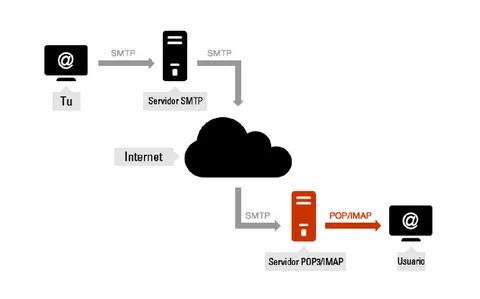We all send and receive scores of emails every day, but many of us aren’t aware of the underlying technologies that make this happen. Email works because of multiple sets of rules, also known as protocols, that enable servers to communicate with each other. The most important one is the Simple Mail Transfer Protocol (SMTP), and the application that supports email exchange by implementing this protocol is called the SMTP server.
This article will show you the benefits of choosing an email service provider (ESP) that offers SMTP services, as compared to having an SMTP server in-house.
Table of Contents
What Is an SMTP Server?
This is the server that is responsible for routing emails using the Simple Mail Transfer Protocol. Whenever you hit the “send” button after typing an email, it is sent to the SMTP server. The server relays your message to the recipient after identifying the specific mail server to send it to. The recipient then retrieves the message using their email client software.
SMTP servers are able to process both incoming and outgoing mail, though it depends on setup. An SMTP server may be configured to process only outbound mail, which is often the case with bulk mailing.
The good news is that you may use different servers for different purposes. For example, you still may set up your own SMTP server to handle mail exchange between your company’s departments, for security reasons, while using external infrastructure for tasks related to communication with clients.
Benefits of Using an SMTP Service Provider
There are many benefits of using a service provider that supports SMTP. Here we will focus on the factors associated with email marketing. You may decide for yourself which advantages are more important for your business.
Easy setup and management
Email is a very mature and stable technology, so once your company’s SMTP server is properly set up, it will most probably run for years without any issues. However, if a problem does occur, it usually means that you’ll need professional assistance to fix it, which may not be readily available. With an SMTP provider, you’ll hardly notice any problems at all, due to the added robustness of the infrastructure.
From a customer’s point of view, the initial setup for an SMTP service provider is much easier compared to having an in-house email server. Using an SMTP API is the easiest option, you just need to specify the login credentials in your client software. For higher speed and advanced features, your applications may have to use a dedicated API; in most cases, your SMTP provider will be able to offer a software module for seamless integration.
Also, as time goes by, you would eventually need to upgrade or replace your SMTP server hardware. With SMTP providers, hardware is upgraded on a schedule, and a good performance margin is kept to easily deal with peak loads.
Higher Speed
When you start a last-minute advertising campaign, you expect the offer to reach your clients as soon as possible, right? Luckily, ESPs keep their servers connected to the major Internet lines with higher throughput, which is a must for sending billions of emails. As a result, a typical bulk mailing takes no more than a few minutes to complete.
In this scenario, the limiting factor is usually your own ability to issue the sending requests, not the provider’s throughput. The extended features ESPs usually offer may help you perform the task even faster. Let’s say, you have a common email template, where details of the offer (like customer name, discount, list of items etc.) are unique to the customer. Instead of preparing the full message body for each recipient, you may just upload the template, and data merging will be done by the provider.
Flexibility and Affordability
As stated above, the provider’s email infrastructure capacity is typically several factors larger than that of a typical small or medium sized business, so you’ll never have to worry about your ability to perform a large campaign on a holiday season.
On the other hand, many small businesses send bulk emails to customers only a few times a year, usually on major events or holiday seasons. With the pricing flexibility most SMTP providers offer, you may be sure you’re not paying for something you do not use.
Improved Deliverability
While setting up an SMTP server is straightforward, maintaining high deliverability rates is far from being so. Spam is a major problem on the Internet, and anti-spam technologies constantly emerge and evolve. To reach users’ inboxes, you must set up email authentication, know which black lists to monitor, and register with postmasters and FBL services, to name just a few vital activities.
With an SMTP provider, these matters are properly taken care of. Typical deliverability scores here are usually 99% or higher. At UniOne, as of January 2023, the average delivery rate for the past 30 days is 99.72%.
Reporting and Data Analysis
If you run your own SMTP server and want to keep track of your delivery rates, monitor email opens and clicks, or remove inaccessible and non-engaged addresses, you will need to find and integrate the necessary tools by yourself. SMTP providers typically offer intuitive reports and dashboards that will show you all necessary information related to your campaigns.
Besides, data on deliveries, opens and clicks is available in real time via callbacks or may be downloaded later for in-depth analysis and data mining using dedicated tools.
Conclusion
We’ve outlined some of the main benefits of using an SMTP provider for email marketing. Be sure to consider all available options and settle on a reputable and affordable provider, e.g. UniOne.





